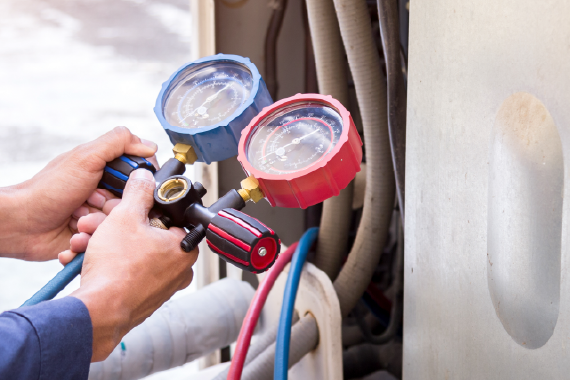We collaborate to achieve sustainable success
Get in touch with usUpskilling for a Cooler Future: Training the Workforce for the New Refrigerant Era
The accelerating F-Gas phase-down, particularly in mid-2025, is not merely a regulatory shift or a technological evolution; it represents a fundamental transformation of the heating, ventilation, air conditioning, and refrigeration (HVACR) industry's workforce. As high-Global Warming Potential (GWP) refrigerants are phased out in favour of new, often mildly flammable (A2L) alternatives and natural refrigerants, the critical need for updated technician training and certification has become paramount. Without a skilled and knowledgeable workforce, the industry's ambitious climate goals, operational safety, and long-term compliance are at significant risk.
The Urgency of the Upskill
The impetus for this massive upskilling effort stems directly from the stringent new regulations. From January 2025, the U.S. EPA mandates that new air conditioning units must use refrigerants with a GWP of 700 or less, effectively phasing out R-410A in new systems. Similarly, the EU and UK have introduced bans on high-GWP refrigerants in new equipment and for servicing existing systems, pushing the adoption of alternatives like R-32 and R-454B.
These new refrigerants, while environmentally superior, often possess different thermodynamic properties and, crucially, different safety classifications. Many are categorized as A2L, meaning they are mildly flammable. This characteristic introduces new safety considerations that demand specialized tools, updated installation practices, and rigorous handling protocols.
The consequences of an untrained workforce are severe:
- Safety Hazards: Improper handling of mildly flammable refrigerants can lead to serious accidents, including fires and explosions, endangering technicians and occupants alike.
- Equipment Damage: Incorrect installation or servicing due to a lack of knowledge can cause costly damage to new, complex systems, leading to premature failures and operational downtime.
- Non-Compliance and Penalties: Businesses face significant fines (up to £200,000 per offense in the UK) and legal repercussions for non-compliance, which includes failing to use certified personnel or maintain proper service records.
- Inefficient Operations: Without proper training, technicians may not be able to optimize the performance of new, energy-efficient systems, undermining their environmental and economic benefits.
What the New Era Demands: Comprehensive Training
The training required for the new refrigerant era goes beyond basic handling. It encompasses several key areas:
- Refrigerant Properties and Safety: Technicians must gain a deep understanding of the characteristics of A2L refrigerants (e.g., R-32, R-454B, R-474A) and natural refrigerants (e.g., CO2, propane, ammonia), including their flammability, toxicity, and pressure requirements.
- Specialized Tools and Equipment: New refrigerants often necessitate different tools for recovery, charging, and leak detection. Training must cover the proper use of these specialized instruments.
- System Design and Installation: Technicians need to understand how new refrigerants impact system design, including updated components like compressors, coils, and valves, and how to ensure proper ventilation and safety measures during installation.
- Leak Prevention and Detection: Stricter leak detection requirements are in place, and technicians must be proficient in identifying and repairing leaks to prevent refrigerant emissions.
- Recovery, Recycling, and Reclamation: With the increasing emphasis on the circular economy of refrigerants, technicians must be trained in the proper procedures for recovering, recycling, and reclaiming F-gases at the end of a product's lifecycle or during servicing.
- Documentation and Reporting: Accurate record-keeping for all refrigerant activities is crucial for compliance, and training should cover these administrative requirements.
Industry Initiatives and Remaining Gaps
Industry associations and manufacturers are actively working to address this training imperative. The European Heat Pump Association (EHPA), for instance, emphasizes the need for workforce readiness through comprehensive training and certification, advocating for updated safety standards and building regulations to support the uptake of natural refrigerants. Events like the "NATURAL REFRIGERANTS 2025" conference provide platforms for experts to share the latest practices and innovations with technicians and engineers.
Manufacturers like Daikin and Lennox are designing new systems to minimize changes to installation requirements where possible but still acknowledge the need for updated training for their new refrigerant-compatible products. The EU has also set a deadline for all personnel handling F-gases to be trained and certified under new EU standards by 2027.
Despite these efforts, challenges remain. The sheer scale of the transition requires widespread access to quality training programs. Overly restrictive safety standards can also impede broader adoption of certain refrigerants, further complicating training efforts. Ensuring that all technicians, especially those in smaller businesses or remote areas, receive the necessary education and certification is a significant undertaking.
The Future is Certified
For businesses, investing in comprehensive training and ensuring their workforce is certified is no longer an option but a strategic necessity. It's an investment that pays dividends in safety, compliance, operational efficiency, and long-term sustainability. Relying on uncertified personnel or outdated practices risks not only financial penalties but also reputational damage and, most importantly, the safety of individuals.
As the F-Gas market continues its rapid evolution in mid-2025, a well-trained and certified workforce will be the cornerstone of a successful, safe, and sustainable cooling future.

